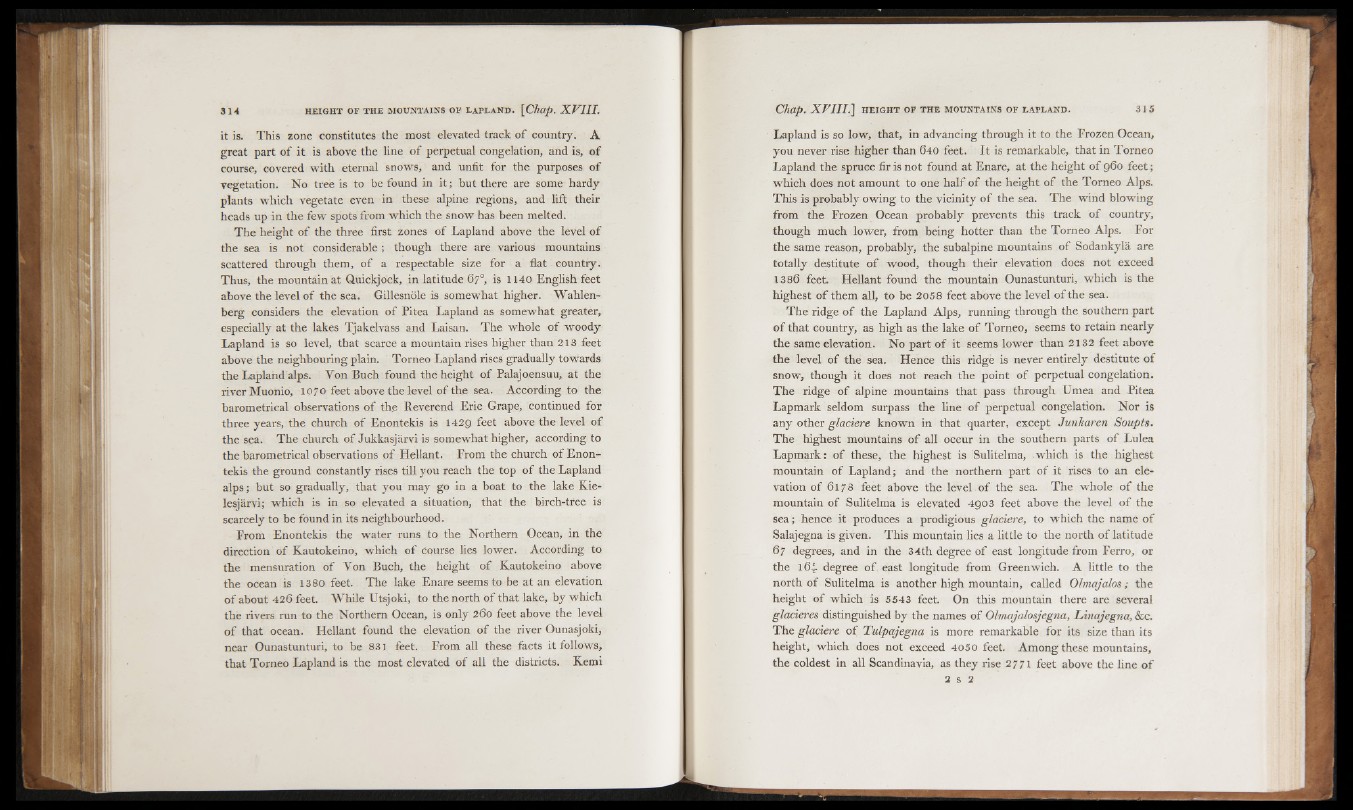
it is. This zone constitutes the most elevated track of country. A
great part o f it is above the line of perpetual congelation, and is, of
course, covered with eternal snows, and unfit for the purposes of
vegetation. No tree is to be found in i t ; but there are some hardy
plants which vegetate even in these alpine regions, and lift their
heads up in the few spots from which the snow has been melted.
The height of the three first zones o f Lapland above the level of
the sea is not considerable; though there are various mountains
scattered through them, of a respectable size for a flat country.
Thus, the mountain at Quickjock, in latitude 67°, is 1 14 0 English feet
above the level of the sea. Gillesnole is somewhat higher. Wahlenberg
considers the elevation of Pitea Lapland as somewhat greater,
especially at the lakes Tjakelvass and Laisan. The whole o f woody
Lapland is so level, that scarce a mountain rises higher than 213 feet
above the neighbouring plain. Torneo Lapland rises gradually towards
the Lapland alps. Von Buch found the height of Palajoehsuu, at the
river Muonio, 1070 feet above the level o f the sea. According to the
barometrical observations o f the Reverend Eric Grape, continued for
three years, the church of Enontekis is 142g feet above the level of
the sea. The church of Jukkasjarvi is somewhat higher, according to
the barometrical observations of Hellant. From the church of Enontekis
the ground constantly rises till you reach the top o f the Lapland
alps; but so gradually, that you may go in a boat to the lake Kie-
lesjarvi; which is in so elevated a situation, that the birch-tree is
scarcely to be found in its neighbourhood.
From Enontekis the water runs to the Northern Ocean, in the
direction of Kautokeino, which o f course lies lower. According to
the mensuration of Von Buch, the height of Kautokeino above
the ocean is 1380 feet.. The lake Enare seems to be at an elevation
of about 426 feet. While Utsjoki, to the north o f that lake, by which
the rivers run to the Northern Ocean, is only 260 feet above the level
of that ocean. Hellant found the elevation o f the river Ounasjoki,
near Ounastunturi, to be 83 1 feet. From all these facts it follows,
that Torneo Lapland is the most elevated of all the districts. Kemi
Lapland is so low, that, in advancing through it to the Frozen Ocean,
you never rise higher than 640 feet. It is remarkable, that in Torneo
Lapland the spruce fir is not found at Enare, at the height o f 960 feet;
which does not amount to one half o f the height of the Torneo Alps.
This is probably owing to the vicinity of the sea. The wind blowing
from the Frozen Ocean probably prevents this track o f country,
though much lower, from being hotter than the Torneo Alps. For
the same reason, probably, the subalpine mountains of Sodankyla are
totally destitute o f wood, though their elevation does not exceed
1386 feet Hellant found the mountain Ounastunturi, which is the
highest o f them all, to be 2058 feet above the level of the sea.
The ridge of the Lapland Alps, running through the southern part
of that country, as high as the lake o f Torneo, seems to retain nearly
the same elevation. No part of it seems lower than 2132 feet above
the level of the sea. Hence this ridge is never entirely destitute of
snow, though it does not reach the point of perpetual congelation.
The ridge of alpine mountains that pass through Umea and Pitea
Lapmark seldom surpass the line o f perpetual congelation. Nor is
any other glaciere known in that quarter, except Junkaren Soupts.
The highest mountains o f all occur in the southern parts o f Lulea
Lapmark: o f these, the highest is Sulitelma, which is the highest
mountain o f Lapland; and the northern part of it rises to an elevation
of 6178 feet above the level o f the sea. The whole o f the
mountain of Sulitelma is elevated 4903 feet above the level o f the
sea; hence it produces a prodigious glaciere, to which the name of
Salajegna is given. This mountain lies a little to the north of latitude
67 degrees, and in the 34th degree o f east longitude from Ferro, or
the 164 degree of east longitude from Greenwich. A little to the
north o f Sulitelma is another high mountain, called Olmajalos; the
height of which is 5543 feet. On this mountain there are several
glacieres distinguished by the names of Olmajalosjegna, Linajegna, See.
The glaciere of Tulpajegna is more remarkable for its size than its
height, which does not exceed 4050 feet. Among these mountains,
the coldest in all Scandinavia, as they rise 2771 feet above the fine o f
2 s 2